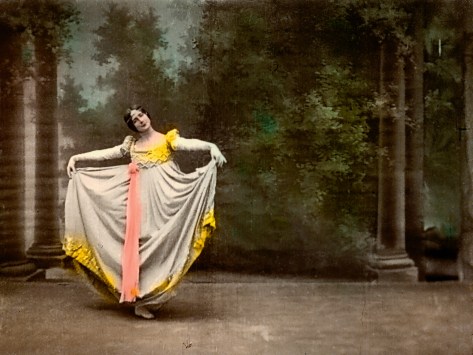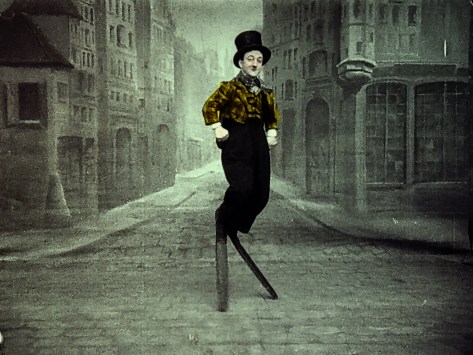
This is a guest post for Silent London by Neil Brand.
Among the gorgeously designed pavilions on the banks of the Seine at the Paris Exposition of 1900 was a small, ornate theatre called the Phono-Cinéma-Théatre, which contained a screen and a small musical ensemble. Across the screen moved the greatest actors, dancers, mimes and clowns of the day – they spoke, they sang, they moved to music provided by musicians playing live and they were often in exquisite, hand-tinted colour. Five years after the birth of cinema, film and recorded sound brought France’s finest theatrical artists to mechanical life for the lucky generation of fin-de-siècle Paris. It was ephemera among ephemera, Toulouse-Lautrec’s posters pulled aside to reveal the artists that inspired him, and, of course, not made to last – half a century of progress and war on an industrial scale would sweep away those films and the spirit of The Banquet Years, as well as millions of those lucky or wealthy enough to experience them, leaving the rest of us with just the books, the posters, a few photos … until last week.

On Thursday last the Giornate del Cinema Muto in Pordenone, Italy, showed 23 surviving films of the 41 originally shot, most complete with their hand-colouring, many with their synchronised sound, almost all accompanied live by a small ensemble directed and arranged by John Sweeney. John had spent months finding as much of the original music to the dances and songs as possible, then rehearsed synchronising them to the pre-recorded singing and dancers’ steps, which were set in stone over a hundred years ago – the result was an astounding time-bridge that placed us all more viscerally in the Paris Exposition auditorium than any sound and image record could have done – the artists were now performing for us, their movements driven by John’s piano, their eyes returning our gaze and their efforts aimed at pleasing us.
It was all so relaxed – Little Tich missed a catch with his hat but just picked it up and carried on as if nothing had happened, the odd dance step was fumbled, but unlike the stiff subjects of so much still photography of the time, our performers did what they did for the camera just as they had done on stage for years (in some cases decades), blissfully uncaring of giving a “definitive” performance or of the legacy of our critical response from an unimaginable distance of posterity.
Sarah Bernhardt fought Hamlet’s duel beautifully, despite her 56 years, and with the addition of Frank Bockius’s uncannily precise sword clashes on triangle; Emilio Cossira sang Romeo’s aria from Gounod’s opera silently, his voice reproduced by Romano Todesco’s single notes on accordion, the intent of feeling vibrant in his features and his genial return for a second bow – Mariette Sully wrung genuine comedy out of singing and dancing “La Poupée” and Cléo de Mérode, La Grande Horizontale to many of the crowned heads of Europe, danced in the way that had turned those heads in the first place.

We found out what made 1900 audiences laugh, thanks to Jules Moy’s anarchic dancing master and Polin’s Troupier Pompette singing about, among other things, stroking a lady’s leg, wondering at the lack of resistance and, on raising her skirt, realising he is touching up the table leg. The entire 90-minute show was a triumph of 1900 and 2012 technology – I have worked with early film for 30 years, and never have I felt so privileged to see these wonders more clearly than any generation before, even the one for which they were intended.
Above all, I now feel I understand turn-of-the-century Paris with a profundity that was impossible before last Thursday night – its potency, its sexuality, within which the highest arts of performance were also the most immediately sensual and arresting, its gaiety and love of sensation, the vibrancy and diversity of its entertainments. The combined efforts of the Cinémathèque Française, Gaumont, Lobster Films, Olivier Auboin-Vermorel and the historical and aesthetic energy of Pordenone director David Robinson have brought not just a corpse but a memory back to life – theatre as film as theatre, a heady concoction only available through the medium of “silent film” – in London, the equivalent would be seeing a complete night at the music hall from 1900, in full colour and with synchronised sound – for now, London must get to see this show, preferably in the perfect surroundings of Hackney Empire where the artists can emerge from the proscenium arch of a Matcham theatre – but maybe after Paris has seen its own long-lost child, this November at the Cinémathèque Française – and, of course, John Sweeney and his ensemble will be there to assist at the rebirth.
Neil Brand

This looks so completely wonderful. I can only hope the powers that be ast the San Francisco Silent Film Festival make an effort to bring this to the Castro.
Thank you for your delightful recap of what looks to be a truly magical experience.
One terrible omission, for which I’m very sorry – the original sound cylinders were lovingly recorded and restored on his own machine, the Archeophone, by Henri Chamoux.
Neil – do you know if there are any plans to bring this to London (or anywhere else in the UK)? It sounds absolutely incredible!